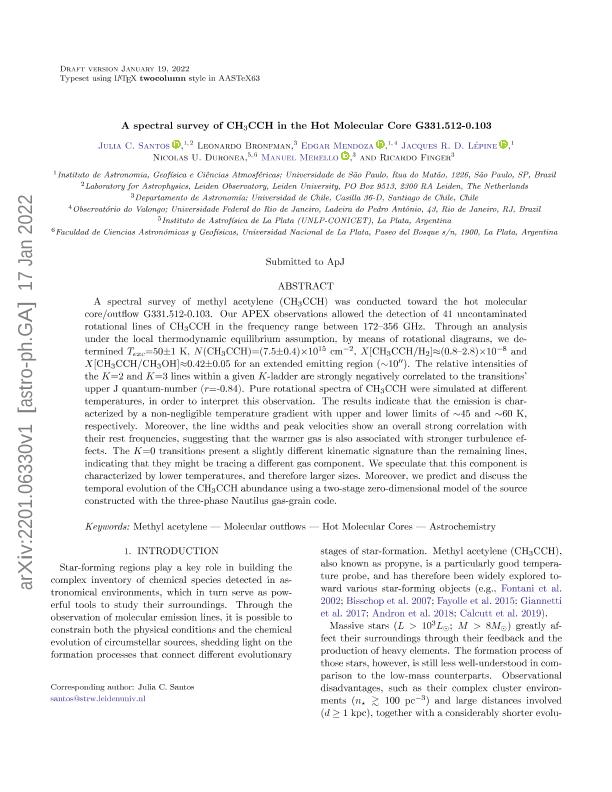Artículo
A Spectral Survey of CH3CCH in the Hot Molecular Core G331.512-0.103
Santos, Julia; Bronfman, Leonardo; Mendoza, Edgar; Lépine, Jacques R. D.; Duronea, Nicolas Urbano ; Merello, Manuel; Finger, Ricardo
; Merello, Manuel; Finger, Ricardo
 ; Merello, Manuel; Finger, Ricardo
; Merello, Manuel; Finger, Ricardo
Fecha de publicación:
03/2022
Editorial:
IOP Publishing
Revista:
Astrophysical Journal
ISSN:
0004-637X
Idioma:
Inglés
Tipo de recurso:
Artículo publicado
Clasificación temática:
Resumen
A spectral survey of methyl acetylene (CH3CCH) was conducted toward the hot molecular core/outflow G331.512-0.103. Our APEX observations allowed the detection of 41 uncontaminated rotational lines of CH3CCH in the frequency range between 172 and 356 GHz. Through an analysis under the local thermodynamic equilibrium assumption, by means of rotational diagrams, we determined T exc = 50 ? 1 K, N(CH3CCH) = (7.5 ? 0.4) ? 1015 cm2, X[CH3CCH/H2] ≈ (0.8-2.8) ? 10-8, and X[CH3CCH/CH3OH] ≈ 0.42 ? 0.05 for an extended emitting region (∼10″). The relative intensities of the K = 2 and K = 3 lines within a given K-ladder are strongly negatively correlated to the transitions' upper J quantum number (r = -0.84). Pure rotational spectra of CH3CCH were simulated at different temperatures, in order to interpret this observation. The results indicate that the emission is characterized by a nonnegligible temperature gradient with upper and lower limits of ∼45 and ∼60 K, respectively. Moreover, the line widths and peak velocities show an overall strong correlation with their rest frequencies, suggesting that the warmer gas is also associated with stronger turbulence effects. The K = 0 transitions present a slightly different kinematic signature than the remaining lines, indicating that they might be tracing a different gas component. We speculate that this component is characterized by lower temperatures and therefore larger sizes. Moreover, we predict and discuss the temporal evolution of the CH3CCH abundance using a two-stage zero-dimensional model of the source constructed with the three-phase Nautilus gas-grain code.
Palabras clave:
Methyl acetylene
,
Molecular outflows
,
Hot Molecular Cores
,
Astrochemistry
Archivos asociados
Licencia
Identificadores
Colecciones
Articulos(IALP)
Articulos de INST.DE ASTROFISICA LA PLATA
Articulos de INST.DE ASTROFISICA LA PLATA
Citación
Santos, Julia; Bronfman, Leonardo; Mendoza, Edgar; Lépine, Jacques R. D.; Duronea, Nicolas Urbano; et al.; A Spectral Survey of CH3CCH in the Hot Molecular Core G331.512-0.103; IOP Publishing; Astrophysical Journal; 925; 1; 3-2022; 1-18
Compartir
Altmétricas



